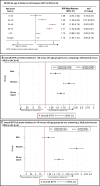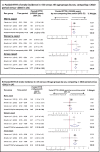Disparities in Stroke Incidence Over Time by Sex and Age in Latin America and the Caribbean Region 1997 to 2021: A Systematic Review and Meta-Analysis
- PMID: 37642019
- PMCID: PMC10547353
- DOI: 10.1161/JAHA.123.029800
Disparities in Stroke Incidence Over Time by Sex and Age in Latin America and the Caribbean Region 1997 to 2021: A Systematic Review and Meta-Analysis
Abstract
Background High-income country studies show unfavorable trends in stroke incidence (SI) in younger populations. We aimed to estimate temporal change in SI disaggregated by age and sex in Latin America and the Caribbean region. Methods and Results A search strategy was used in MEDLINE, WOS, and LILACS databases from 1997 to 2021, including prospective population-based observational studies with first-ever stroke incidence in Latin America. Reports without data broken down by age and sex were excluded. Risk of bias was assessed with The Joanna Briggs Institute's guide. The main outcomes were incidence rate ratio and relative temporal trend ratio of SI, comparing time periods before 2010 with after 2010. Pooled relative temporal trend ratios considering only studies with 2 periods in the same population were calculated by random-effects meta-analysis. Meta-regression analysis was used to evaluate incidence rate determinants. From 9242 records identified, 6 studies were selected including 4483 first-ever stroke in 4 101 084 individuals. Crude incidence rate ratio in younger subjects (<55 years) comparing before 2010:after 2010 periods showed an increase in SI in the past decade (incidence rate ratio, 1.37 [95% CI, 1.23-1.50]), in contrast to a decrease in older people during the same period (incidence rate ratio, 0.83 [95% CI, 0.76-0.89]). Overall relative temporal trend ratio (<55:≥55 years) was 1.65 (95 CI%, 1.50-1.80), with higher increase in young women (pooled relative temporal trend ratio, 3.08 [95% CI, 1.18-4.97]; P for heterogeneity <0.001). Conclusions An unfavorable change in SI in young people, especially in women, was detected in population-based studies in the past decade in Latin America and the Caribbean. Further investigation of the explanatory variables is required to ameliorate stroke prevention and inform local decision-makers. Registration URL: https://www.crd.york.ac.uk/prospero/ Identifier: CRD42022332563.
Keywords: epidemiology; intracranial hemorrhage; ischemic stroke; women, sex, and gender.
Figures


Comment in
-
Challenges in Assessing Stroke Incidence in Low- and Middle-Income Countries.J Am Heart Assoc. 2023 Sep 5;12(17):e031292. doi: 10.1161/JAHA.123.031292. Epub 2023 Aug 29. J Am Heart Assoc. 2023. PMID: 37642036 Free PMC article. No abstract available.
Similar articles
-
Prevalence and incidence of stroke in Latin America and the Caribbean: a systematic review and meta-analysis.Sci Rep. 2023 Apr 26;13(1):6809. doi: 10.1038/s41598-023-33182-3. Sci Rep. 2023. PMID: 37100856 Free PMC article.
-
Diverging Temporal Trends in Stroke Incidence in Younger vs Older People: A Systematic Review and Meta-analysis.JAMA Neurol. 2022 Oct 1;79(10):1036-1048. doi: 10.1001/jamaneurol.2022.1520. JAMA Neurol. 2022. PMID: 35943738 Free PMC article.
-
Trends in stroke mortality in Latin America and the Caribbean from 1997 to 2020 and predictions to 2035: An analysis of gender, and geographical disparities.J Stroke Cerebrovasc Dis. 2025 Jun;34(6):108286. doi: 10.1016/j.jstrokecerebrovasdis.2025.108286. Epub 2025 Mar 13. J Stroke Cerebrovasc Dis. 2025. PMID: 40089216
-
Prevalence and incidence of epilepsy in Latin America and the Caribbean: A systematic review and meta-analysis of population-based studies.Epilepsia. 2021 Apr;62(4):984-996. doi: 10.1111/epi.16850. Epub 2021 Mar 2. Epilepsia. 2021. PMID: 33651439
-
Prevalence and incidence of chronic obstructive pulmonary disease in Latin America and the Caribbean: a systematic review and meta-analysis.BMC Pulm Med. 2022 Jul 16;22(1):273. doi: 10.1186/s12890-022-02067-y. BMC Pulm Med. 2022. PMID: 35842603 Free PMC article.
Cited by
-
Risk and impact of stroke across 38 countries and territories of the Americas from 1990 to 2021: a population-based trends analysis from the Global Burden of Disease Study 2021.Lancet Reg Health Am. 2025 Feb 15;43:101017. doi: 10.1016/j.lana.2025.101017. eCollection 2025 Mar. Lancet Reg Health Am. 2025. PMID: 40034838 Free PMC article.
-
Challenges in Assessing Stroke Incidence in Low- and Middle-Income Countries.J Am Heart Assoc. 2023 Sep 5;12(17):e031292. doi: 10.1161/JAHA.123.031292. Epub 2023 Aug 29. J Am Heart Assoc. 2023. PMID: 37642036 Free PMC article. No abstract available.
-
2025 Heart Disease and Stroke Statistics: A Report of US and Global Data From the American Heart Association.Circulation. 2025 Feb 25;151(8):e41-e660. doi: 10.1161/CIR.0000000000001303. Epub 2025 Jan 27. Circulation. 2025. PMID: 39866113 Review.
-
Temporal trends and epidemiological impact of metabolic risk factors on stroke burden in Chinese individuals aged 65 and older, 1992-2021.Front Neurol. 2025 Jul 29;16:1607823. doi: 10.3389/fneur.2025.1607823. eCollection 2025. Front Neurol. 2025. PMID: 40800686 Free PMC article.
-
Trends in stroke incidence, death, and disability outcomes in a multi-ethnic population: Auckland regional community stroke studies (1981-2022).Lancet Reg Health West Pac. 2025 Mar 10;56:101508. doi: 10.1016/j.lanwpc.2025.101508. eCollection 2025 Mar. Lancet Reg Health West Pac. 2025. PMID: 40143891 Free PMC article.
References
-
- Lavados PM, Hoffmeister L, Moraga AM, Vejar A, Vidal C, Gajardo C, Portales B, San Martín D, Lopez E, Rojo A, et al. Incidence, risk factors, prognosis, and health‐related quality of life after stroke in a low‐resource community in Chile (ÑANDU): a prospective population‐based study. Lancet Glob Health. 2021;9:e340–e351. doi: 10.1016/S2214-109X(20)30470-8 - DOI - PubMed
-
- Feigin VL, Roth GA, Naghavi M, Parmar P, Krishnamurthi R, Chugh S, Mensah GA, Norrving B, Shiue I, Ng M, et al. Global burden of stroke and risk factors in 188 countries, during 1990–2013: a systematic analysis for the Global Burden of Disease study 2013. Lancet Neurol. 2016;15:913–924. doi: 10.1016/S1474-4422(16)30073-4 - DOI - PubMed
-
- Feigin VL, Stark BA, Johnson CO, Roth GA, Bisignano C, Abady GG, Abbasifard M, Abbasi‐Kangevari M, Abd‐Allah F, Abedi V, et al. Global, regional, and national burden of stroke and its risk factors, 1990–2019: a systematic analysis for the Global Burden of Disease study 2019. Lancet Neurol. 2021;20:795–820. doi: 10.1016/S1474-4422(21)00252-0 - DOI - PMC - PubMed
Publication types
MeSH terms
LinkOut - more resources
Full Text Sources
Medical
Miscellaneous

